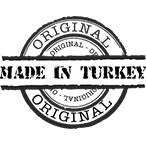Oil Absorbents
Oil absorbers are materials designed to separate oil from water and other liquids, used in case of oil leaks and spills. These products are widely used in industrial facilities, workshops, the marine industry and environmental clean-up operations. The main purpose of oil absorbers is to reduce environmental damage by absorbing oil and other hydrocarbon-based liquids.
Oil Absorbents
Oil Absorbents are specialized materials used to absorb and control oil and other petroleum-based liquids. Commonly used in industrial facilities, workshops, the maritime sector, and environmental cleanup operations, these materials help in the quick and effective cleanup of oil spills.
Oil Absorber Types
Oil absorbents can be made from a variety of materials and in a variety of shapes. The most common oil absorbents materials are:
- Absorbent Granule: Absorbent bio granule is a natural absorbent material used to absorb oil and chemical spills. It is produced from vegetable fibers and is an environmentally friendly product.
- Absorbent Particulate: Oil absorbent particle are small, dried pieces used to absorb oil and chemical spills. It is usually produced from cellulose, zeolite or synthetic materials.
- Absorbent Pillows: An oil absorbent pad is a thick absorbent material used to absorb oil and chemical spills. It is usually produced from paper, cotton or synthetic materials.
- Bilge Socks: Bilge absorbent is an absorbent material used to absorb oil and chemical spills from the bilge on ships. It is usually produced from paper, cotton or synthetic materials.
- Absorbent Socks: An oil absorbent swab is a long, cylindrical absorbent material used to absorb oil and chemical spills. It is usually produced from paper, cotton or synthetic materials.
- Oil Absorbent Boom: An oil absorbent sausage is a long, cylindrical absorbent material used to absorb oil and chemical spills. It is usually produced from paper, cotton or synthetic materials.
- Oil Absorbent Roll: An oil absorbent roll is a long, cylindrical absorbent material used to absorb oil and chemical spills. It is usually produced from paper, cotton or synthetic materials.
- Oil Absorbent Pad: An oil absorbent pad is a thick absorbent material used to absorb oil and chemical spills. It is usually produced from paper, cotton or synthetic materials.
Features and Functions of Oil Absorbents
-
Selective Absorption Capacity:
- Oil absorbents specifically target oil and petroleum-based liquids while largely not absorbing other liquids like water. This feature is ideal for separating oil spills from the water surface.
-
Various Application Areas:
- Industrial Facilities: Used to clean oil spills and leakages and ensure safety in workplaces.
- Maritime: An effective tool for responding to oil spills in seas and ports.
- Environmental Cleanup: Used in cleaning up oil spills resulting from natural disasters or accidents.
-
Available in Different Forms:
- Oil absorbents come in various forms such as pads, rolls, socks, pillows, and mats. This allows for adaptability to different spill scenarios and application areas.
-
Environmental Safety and Waste Management:
- Oil absorbents prevent spilled oil from harming the environment, thereby reducing environmental pollution.
- After use, absorbent materials are sent to specialized waste collection points or disposed of safely.
-
Ease of Use and Storage:
- The use of oil absorbents is generally straightforward and provides effective waste management. They should also be stored in a dry, clean environment.
Application and Sustainability
- Effective use of oil absorbents requires the selection and application of the right material.
- These materials are important for increasing safety in workplaces and providing rapid response in environmental disasters.
- Sustainable practices contribute to reducing environmental impacts and preserving natural resources.
Oil absorbents are critically important for the quick and effective management of oil spills and leakages. They are widely used in various industrial and environmental applications for cleaning and containing oil spills.
Read More


